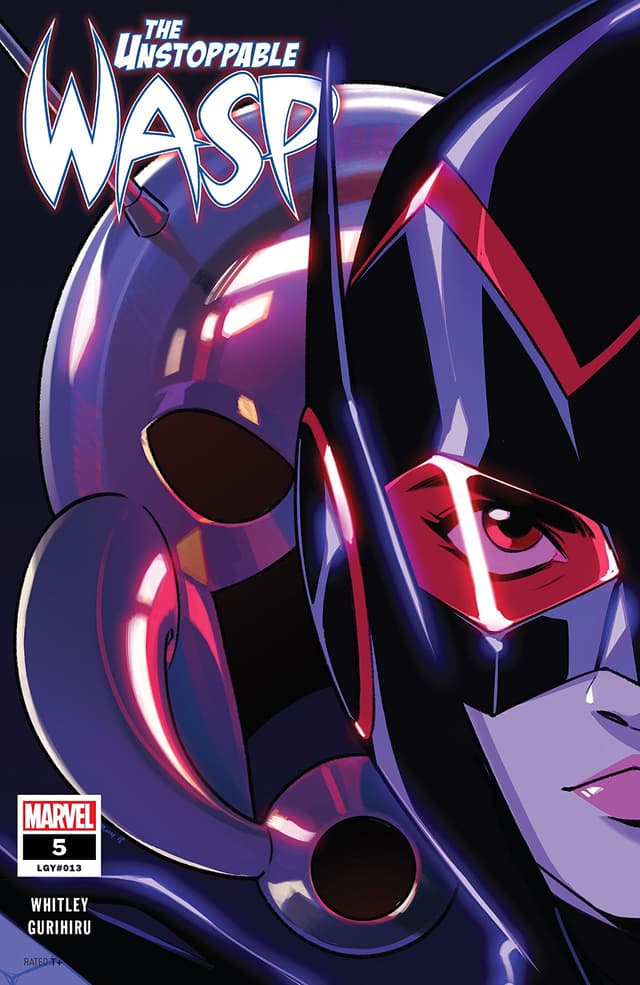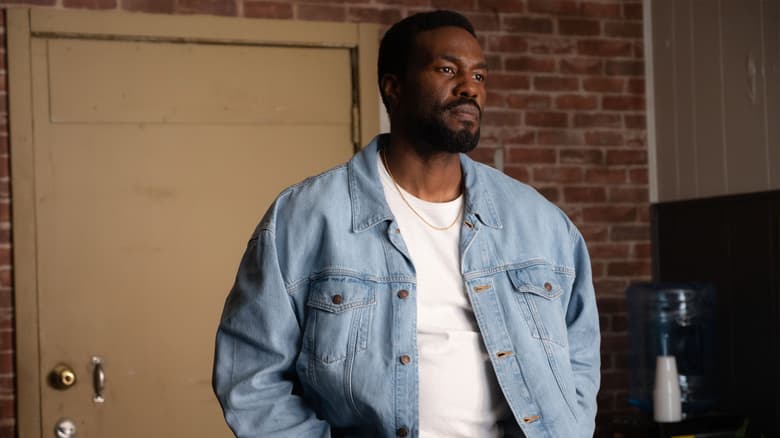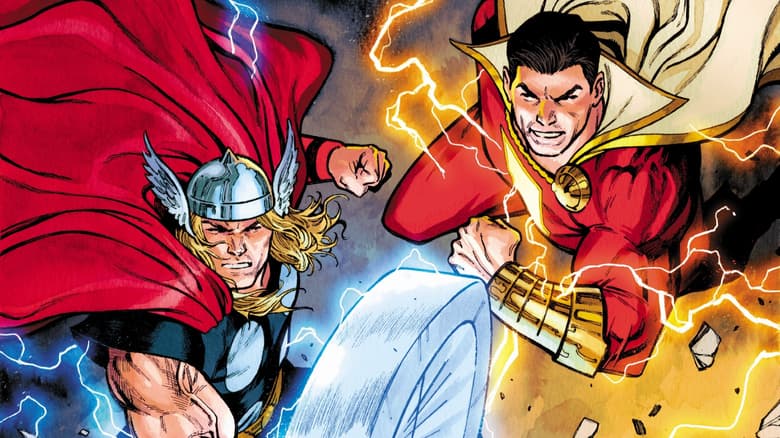Exploring Mental Illness with 'Unstoppable Wasp'
Writer Jeremy Whitley speaks to Marvel.com about the care behind issue #5.
Since the very beginning, Marvel Comics has presented its Super Heroes as, above all else, people.
Matt Murdock manages his blindness, Bruce Banner copes with his anger, and Charles Xavier contends with his paralysis while, concurrently, Daredevil protects Hell's Kitchen, the Hulk smashes Super Villains, and Professor X leads a school of gifted youngsters.
While these characteristics are what help make our heroes human, they do not define them or weaken them; they're simply a part of who they are.
In the same way, today's UNSTOPPABLE WASP #5 sees its eponymous hero at a crossroads in her life. As Nadia Van Dyne encounters her mental illness for the first time, she and the Agents of G.I.R.L. grapple with its powerful effects while never losing sight of their love for—and responsibilities to—themselves and each other.
Written by Jeremy Whitley with art by Gurihiru, this story—covered today in the New York Times—is set to change everything about Nadia’s life.

Marvel.com sat down with Whitley to discuss crafting the story with care, shaping a character in new ways, and the fan reaction to this emotional tale.
Marvel.com: What led you to decide to "give" Nadia a bipolar disorder?
Jeremy Whitley: It was something my editor, Alanna Smith, and I discussed a great deal. We felt it was an opportunity to present a representation of mental illness that we don't frequently see in comics.
Historically, comics have blamed villainous tendencies on mental illness. This has resulted in some characters having entire galleries of "crazy" villains and heroes frequently doing things that are mentally unhealthy and feeling very little consequence. What we wanted to show was a character who is overwhelmingly associated with positivity and optimism who is forced to face her own limitations. Some characters are defined by taking on too much, by pushing themselves past the limits of their body, and in Nadia's case these actions can be both a trigger for and a symptom of her disorder.
Marvel.com: When in the process of writing the character/conceiving of a direction for the title did the idea occur to you? How did it shape your characterization of her going forward?
Whitley: It was something we talked about from the very beginning. Our first hints of this actually appear in the issue of ALL-NEW ALL-DIFFERENT AVENGERS that I co-wrote with Mark Waid before UNSTOPPABLE WASP even started. Nadia is shown to be a character who believes that everything can be solved through science, including issues that are human or emotional in nature. She's also shown to be someone that will push herself past the point of health and personal safety to help other people.
When we started working on UNSTOPPABLE WASP, we talked about from the beginning that this is something we would like to introduce into the character, but we wanted to make sure that Nadia was defined by more than just her illness. Making sure Nadia's story wasn't simply the story of her disorder was important. As with real people, bipolar disorder is just one facet of a complex and interesting person, so it was important to Alanna and I that we really establish who and how Nadia was before we go deeply into this one particular piece of her.
Marvel.com: How aware of bipolar were you before deciding to incorporate it into the book? How did you set about getting a whole and thorough understanding of it?
Whitley: I was definitely aware of bipolar disorder beforehand. I have friends who have struggled with it in their own lives, either personally or through family members. It wasn't something I knew intimately, but I was very conscious of it.
Before I wrote about it in the book, I wanted to make sure I had a good lock on it. I started by reading up from a strictly medical standpoint. I wanted to have an understanding of what it was clinically and how it functioned. It's often a pitfall in fiction that writers are more interested in a symptom than a disease or disorder and the condition ends up being poorly defined.
Probably more important to me though, was talking to and reading stories from people who have dealt with the condition themselves. It's good to know generally what it looks like, but it's also important to understand what it feels like when you're writing a character. So I consulted quite a bit on this, which you can see if you check out the "special thanks" in these issues.
Marvel.com: As you learned about it, did anything strike you about bipolar disorder that you found unexpected based on your initial knowledge? Anything that really altered how you viewed the disorder?
Whitley: I think the trickiest thing with bipolar disorder was just how cleanly descriptions of experiencing bipolar mania line up with what we expect from a superhero. People who have manic episodes often describe it was feeling like they can do anything, like they're superhuman. When people are experiencing mania they often don't feel the need to eat or sleep. It's an incredible high where things that frequently seem impossible seem simple. The reality of the situation is that mania is the really dangerous part of the disorder, because not sleeping or eating has effects on your ability to process and perform normal tasks. When you're a superhero, the potential to cause harm when you can't concentrate or control your actions is pretty huge.

Marvel.com: Related to that, one of the fascinating things you have done so far with Nadia and her living with bipolar is to have her manic episode spark uses of her powers. In grad school, one of the classic examples of a manic episode was someone in the midst of such an incident trying to push a car uphill because their energized state made them feel as though they were super strong. Nadia, however, is a literal super hero. She can, as she does, shrink down to such a small state that she can exist in a realm where time moves differently.
Beyond just noting how effective I found that, I was curious how you decided to portray the episode thusly? We have seen Pym have manic episodes, but the results were always sort of common: increased energy, erratic or risky behavior, and so on. I cannot recall an earlier instance of the bipolar and super powers interacting in this way.
Whitley: Well, it seemed like a logical extension to me. Nadia has all this energy and feels the need to fix these huge problems, but time is moving so quickly that she just isn't accomplishing what she wants to do. Then she realizes she has the ability to shrink down into this crystal and give herself all the time in the world. Of course, she doesn't do this with any regard for her own well-being, so things go sideways pretty quickly, but to her this just makes sense - just like it makes sense to that grad student that they should be able to push a car up a hill.
The tiny lab also works as kind of a cheat for the story. Because in the couple of hours that it takes the rest of the UNSTOPPABLE WASP crew to figure out what Nadia is dealing with, Nadia is able to push herself through an entire week of not sleeping or eating. We can escalate the stakes and illustrate the dangers of mania very quickly. As becomes evident in issue #5, it also lets us accelerate the change from mania to depression much faster than it would occur in real life - because Nadia is experiencing time at a different rate than our other characters.
Marvel.com: There is a danger, I'd imagine, in losing the character to the illness. How do you balance the desire to be honest about Nadia as someone with bipolar without it becoming her entire "story"?
Whitley: It's going to be a balancing act. It's not unlike Storm and her claustrophobia. It's a compelling aspect of the character, but when every story results in Storm being stuck somewhere small and dark, it's a problem. I feel like the '90s X-Men animated series had that issue a bit.
For Nadia, it's something we're going to have to figure out as we go - just like people who deal with the issue in real life. It doesn't go away, but with medication and therapy, it can be better. On the other hand, if Nadia finds herself teleported into the depths of space without her medication, that's a real wrinkle she'll have to deal with. One of our consultants on issue 6 specifically said in a dialog suggestion that "disability will always be a part of you, but it doesn't have to define you" and I think that's an important message to carry on into future UNSTOPPABLE WASP stories.
Marvel.com: Similarly, how has it been to write her supporting cast reacting to the episode? How did you find the reactions that felt authentic to them?
Whitley: I feel like that was one of the most important small aspects of the story. These characters all care about Nadia, but they're not all going to react the same way. Nadia hurts people in this story and that doesn't just undo itself because a person is generally nice. A story of this magnitude threatens to swallow the supporting cast into a Greek chorus, but it's particularly important to me that what everybody does both during and after their encounter with Nadia is informed by who that character is and what we know about them. People who walk away do so as much from aspects of their own character as the people who stay.
Marvel.com: Any insight to how Nadia feels about this as she moves through it? I have a really close friend who used to talk about it as knowing that there was something in her head that would occasionally throw a switch and disrupt her entire life. I imagine for Nadia, someone who is very dedicated to the power of the brain--hers and others--this must be a disconcerting new facet of her own mind.
Whitley: There's actually quite a bit of discussion about how Nadia feels about it in issue #5, so I'll leave that to people to read. Suffice to say, it's not anything anybody knows how to deal with the first time they experience it.
Marvel.com: Have you received feedback from fans with the disorder or familiar with it? How is it being received?
Whitley: I have! The feedback has been overwhelmingly positive and I am so grateful to the fans who have reached out for sharing their experiences. It's my hope that people may read this book and understand that they're not alone and that sometimes even superheroes experience things in their lives that are beyond their control.
Marvel.com: How about for yourself? Looking at the work up until this point and comparing to your thoughts when you conceived of this avenue, how do you feel about the execution so far? How has the actual writing of it changed your conception of the disorder, of Nadia, or of any of the other story elements?
Whitley: At the risk of sounding like I'm making a joke, I've gone through cycles with how I feel about this story.
Before I wrote it I was in love with the idea and so excited about getting to it. When I was writing it, it proved to be one of the most difficult stories I've ever written. I've been responsible for the personality and world of Nadia for so long and I love the character so much that putting her through such a difficult and painful experience was really difficult for me. Thankfully Alanna was very positive and reassuring when reading the first drafts and I started to think I'd done a good job.
Then as it got closer to coming out, I had this overwhelming feeling of dread that people who had gotten so attached to this character were going to read this story and hate me for what I was putting her through. Thankfully, when it came out, all of the amazing reactions certainly helped me to feel better about it. Now I'm back to being excited about this story being out in the world and hopefully allowing someone who needs to read it to read it. Nadia's an incredible character and I feel very lucky to have been a part of her story to this point. Hopefully I get to do that for a lot longer.
Marvel.com: Where does Nadia, the character, and UNSTOPPABLE WASP, the book, go from here? Not necessarily just in a "tease" kind of way, but your thinking on how you see this opening up storytelling avenues going forward?
Whitley: Well, we have a couple of special single issues stories coming up that will deal a bit with where Nadia is now and where she's going, but soon we have to get to the GIRL Expo that Janet has been planning since issue 1 of this volume. That one's going to be a lot of fun. Oh and we gotta get caught up with those AIM girls. They've gotten away with too much already.
Read UNSTOPPABLE WASP #5 at your local comic shop today.
The Daily Bugle
Can’t-miss news and updates from across the Marvel Universe!




